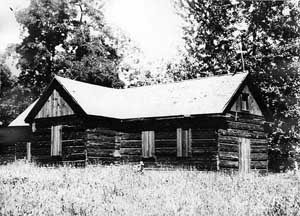On April 3, 1852, Father Louis Joseph D'herbomez and Father Charles M. Pandosy found a mission on Ahtanum Creek in what will become known as the Yakima Valley. They call the mission Saint Joseph (not Sainte Croix as some sources state). The mission will be burned down during the Yakama Indian War of 1855.
Fathers D’herbomez and Pandosy were Missionary Oblates of Mary Immaculate. The priests were sent by Bishop F. N. Blanchet (1795-1883) to serve the Northwest and introduce Catholicism. Blanchet was on good terms with many Indian leaders, and at their request sent priests into the Yakima and Kittitas valleys.
Father Pandosy had traveled to New York from Le Havre, France, while still a seminarian, hoping to become a missionary in what was then known as Oregon territory. Together with Bishop Blanchet and fellow seminarian Eugene Chirouse (1821-1892), who had accompanied him from France, he made his way across the country, arriving in Walla Walla in autumn 1847. In January 1848 the two seminarians were ordained as Catholic priests, the first such ordination in what would become the state of Washington.
Father Pandosy served first at the Saint Rose Mission near what would become Richland, then at the Immaculate Conception Mission near Manastash Creek outside what would become Ellensburg. Father D’herbomez was a newly recruited priest in the Oblates of Mary Immaculate when he came to the Yakima Valley in 1851.
Saint Joseph Mission was built at the main summer camp of Yakama Chief Kamiakin (ca. 1800-1877). The Fathers established the Mission there at Kamiakin's request. The land, covered with silver-gray sagebrush, was dry but fertile. The Fathers and Chief Kamiakin's men worked side by side to dig primitive irrigation canals, the first in the region. The crops they raised on the irrigated land (wheat and corn, along with pumpkins, melon, and potatoes) demonstrated in a small way the region's vast farming potential.
Kamiakin’s relations with the Catholic Fathers were sufficiently warm that he brought his children to the mission to be baptized into the Catholic faith. Following this lead, other Yakama tribespeople also sought baptism.
The priests lived in severe poverty, wearing only tattered robes. Saint Joseph Mission historian Cary Campbell reports that Father Pandosy, "because he had no shoes, walked in his bare feet from what is now present day Ellensburg to Walla Walla to present a personal report to Bishop Blanchet" (Campbell). Kamiakin gave them meat from his hunting and vegetables in season.
In 1854 Father D’herbomez was sent to the Olympia area. Father Pierre Paul Durieu replaced him. Father Pandosy taught the Yakama people French, Latin, and English. He also compiled a dictionary in the Yakama language.
In October 1855, growing hostility between the Yakama peoples and white miners and soldiers came to a head, and the conflict later known as the Yakama Indian War began.
On November 14, 1855, faced with advancing U.S. soldiers, both the missionaries and Indian families fled, as Yakama warriors protected their retreat. Soldiers under the command of Major Gabriel Rains, commander for the U.S. army at Fort Vancouver, poured onto the mission grounds.
The soldiers discovered a cask of gunpowder buried in the missionaries’ garden. Assuming this to be evidence that the Catholic Fathers were aiding the Yakamas in their struggle with the soldiers (and needing very little convincing that this was so) the soldiers set fire to the mission and burned it to the ground. A nearby Oblate mission, Holy Cross in the lower Ahtanum Valley, was also burned.
In September 1867, Father Louis Napoleon St. Onge, a Diocesan priest, and Brother John Baptist Boulet re-established the Saint Joseph Mission at Ahtanum. Initially services were held in the small log cabin that also served as their home.
In spring 1868 priests began rebuilding the mission, assisted by the Yakama people. (Kamiakin had been exiled from Yakama lands in 1855.) The mission was completed in 1870 and Bishop Blanchet dedicated it on July 15, 1872. Jesuit priest Father Joseph Caruana arrived in 1870 and Father Urban Grassi (also a Jesuit) in 1871.
On January 3, 1871, President Ulysses S. Grant's (1822-1885) "Indian Peace Policy" put Indian Affairs agencies directly under the control of missionaries of various Christian religions. "So arbitrarily did it divide them across denominations that Catholics got not the expected half but merely seven out of eighty-eight" wrote a later Jesuit historian (Burns, p. 366). In the Yakima Valley, Methodist minister Reverend Mr. J. H. Wilbur was put in charge of the Yakama. Wilbur, strongly anti-Catholic, forbade Catholic clergy from entering the reservation upon which the Yakama were being confined.
The rebuilt mission at Ahtanum was closed. Father Caruana built Saint Joseph Church in nearby Yakima City (now Union Gap). The wooden church structure was moved, along with the other town buildings, to North Yakima (now Yakima) in 1884. In 1900 that church was replaced with a larger building. Many white settlers were flooding the region, and Catholicism in the valley kept pace.
In the early 1900s, the Knights of Columbus repaired the rebuilt mission building at Ahtanum. The grounds around the mission were converted to parkland. On December 22, 1970, the Saint Joseph Mission was listed on the National Register of Historic Places. As of 2003 religious services were held there regularly.

